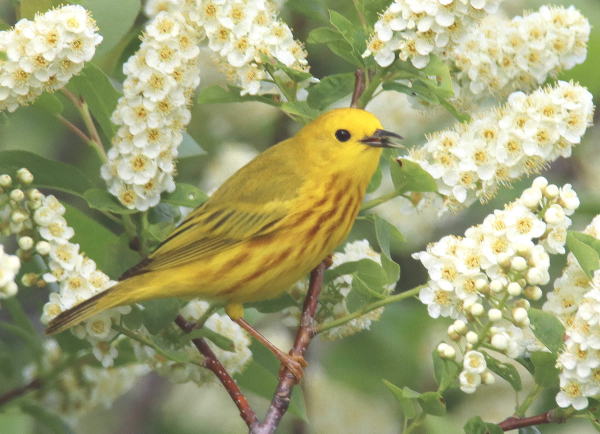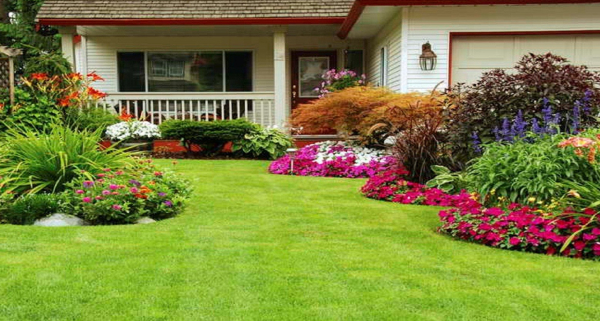
With a small insect in its bill, this Yellow Warbler was attracted to flowering chokecherry trees; stands of chokecherries also provide escape cover, nesting sites, and resting areas, as well as late-summer berries (photo by Paul Konrad).

Landscaping and gardening with birds in mind can provide a renewed incentive to make your yard more decorative in the process.
|
Welcoming birds into our yards is multi-faceted, and for many of us it’s a year-round endeavor, or at least it serves us – and the birds – year-round. Spring is when we tend to emphasize yard improvements in our landscaping and flower gardens, and while we make our surroundings more attractive for ourselves, our family, and neighborhood, it’s easy to keep birds in mind at the same time. Each of our yards contributes to increase bird habitat over much larger areas, at neighborhood, city, and state levels – and there is no end to the ways our personal landscaping can influence birds’ welfare through future years.
Varied backyard habitat can influence bird diversity and abundance that continues well beyond our yards. The birds we benefit with welcoming birdscaped yards also populate other areas that may stretch north to the boreal forest region or even the Arctic tundra, and many species spend winters in areas of Latin America. “Our birds” populate distant lands at different times of the year, and our landscaping and yard improvements provide areas of habitat, however small or large.
Think of your yard as a potential bird oasis that provides a mix of micro-habitats that will attract and benefit a variety of birds – especially birds you most enjoy seeing and sharing your yard with. Make it an oasis for you first – and often that will benefit birds too; and you can always make some areas of your property areas of birds-first landscaping.
Birdscaping Ideas
Some of the simpler aspects to consider include arranging gardens and landscaping elements by elevations: Position shorter plants in the front, taller plants in the rear. Try creating circles and ovals of flower colors, and curved borders to replace traditional straight lines or rectangles of planted flowers, shrubs, and trees. Consider how mixing deciduous and coniferous trees and bushes adds shades of color and depth, as well as varied habitat types for birds. Also take into account which parts of your yard are sunny and where there is shade; some plants prefer one or the other, so you will want to plant accordingly.
We also try to think about nesting cover, and escape cover for birds, providing some areas where branches and leaves add cover. We like to emphasize planting trees, bushes, and gardens that produce berries, fruit, or seeds for summer and fall birds to utilize, although the flowers produced in the spring will also attract birds that feed on flower nectar and small insects that are also attracted. Consider adding a mix of annual and perennial plants; your plantings will be more attractive if they include a diversity of different plants – and we try to emphasize selecting plants that are native to our region.
Going a Bit More Native
Landscaping for birds is usually complimented best by emphasizing native plants, especially natives that provide multiple benefits to birds – cover, flowers, berries or fruit, seeds, or some combination of these elements. It is also very helpful to provide varied vertical elements, some tall, some low, others in between; and it’s good to keep horizontal variations in mind too.
Native plants grow and thrive better in their natural range where they have adapted to the soil, annual rainfall levels, the range of temperatures, and other conditions. Likewise, birds and other animals have adapted to the qualities of native plants’ leaves, flowers, berries, fruits, and seeds. Native birds do best where native plants are available.
As many as 96 percent of terrestrial birds raise their nestlings on insects, and because native insects didn’t evolve with non-native plants, most bugs lack the ability to process the non-native plants’ chemical defenses so aren’t attracted to them as food sources. Also, if you are inviting birds into your yard, it’s best to try to reduce or eliminate the use of pesticides and herbicides to keep your landscaping plants and the birds they attract healthiest.
We have carved out areas for native plants to break up the mowed lawn, thereby adding attractive islands of native plants. It’s a real plus for the overall look of our yard, and for the birds too. Although it’s probably best to look into local sources of information about native plants, a good information source to start with may be the Find Your Resources — HOMEGROWN NATIONAL PARK and the National Wildlife Federation’s “Native Plant Finder” at Specify Your Location - Native Plants Finder (nwf.org)
Water & Feeding Resources
A water source is also important, whether it’s a birdbath, dual birdbaths in the front and backyard areas, or another water feature – perhaps a mini-fountain or mini-waterfall. Consider adding a natural-looking water feature that includes the trickle of running water to your yard – a pleasing sound for you, and a magnet for birds. Whether it’s a simple elevated basin filled with water or a grandiose water feature, water attracts a greater variety of birds than any food you can offer – and it may be the missing landscaping element in your neighborhood that makes a difference in attracting more birds to your property.
Your feeding station can be considered a central point that you can surround with landscaping elements too. We like to plant flowers around our feeding station to improve its look, or at least to change its look during the growing season. By including red tubular-shaped flowers, hummingbirds will find the combination of nectar from your nectar feeder and nectar from the flowers doubly attractive. You can also add a couple large rocks or a decorative log to add accented natural ingredients to your landscaping that will double as new perches for birds.
Potted plants can be great addition to your yard, patio, deck, or balcony, whether you live in a condo or apartment, have a city yard, or a larger property. Think big pots – pots that even small trees and bushes can live in. Trumpet vines, preferred by hummingbirds, are a great addition to any yard or balcony. There is no limit to the number of flowering plants you can pot, and one of the nice things about potted plants is that you can move them to change up the look in your yard. We like to use especially decorative colorful pots that can be as eye-catching as the flowers we plant.
if you are wondering what kinds of red tubular flowers you can plant to attract hummingbirds, start with trumpet vine, salvia, honeysuckle, cardinal flower, and bee balm – any one of them is a winner; all of them together creates a resort for hummingbirds. We also like to mix in some sunflowers, large and small to provide seeds for wild birds to utilize, and you may find some regional plants that are important seed producers to add too.
Decorative Grass
While you may be thinking of planting a tall decorative grass in your yard, we’ve found that an easy and often overlooked option to break up areas of traditional mowed lawn is to allow a few areas of lawn grass to grow tall, mature, and seed. You can try this within a small area, say an irregularly shaped oval 10 feet in diameter, and build on that if you like the look, perhaps by adding other islands of taller grass. This serves to break up the monotony of a traditional mowed yard, and we really enjoy the look of the resulting tall grass cover as it adds a flair to our landscaping, and a different shade of green.
It’s also nice to see the grass wave in the wind, and the seed heads attract ground feeding birds, such as doves, towhees and native sparrows, thrashers, juncos, and others that use the “new habitat.” Areas of longer grass also add some extra cover where birds can retreat when needed. In addition to islands of tall grass, or even a peninsula of unmowed grass extending from an area of taller bushes, we like to let the grass surrounding each tree in our yard grow taller, creating a tall grass perimeter that extends a foot or 2 around each tree trunk. This treatment creates quite a distinctive look, and there’s no need for a weed whacker in our yard.
One yard – your yard – can make a difference, but it’s probably not an island. When we begin to combine your yard with others in the neighborhood, in your area of town, in towns across your state, the varied elements of each yard’s contributions to available bird habitat is important – really important. Small property owners can be an important link in adding more, new, and better habitat for birds, as they migrate, nest, and winter. Every little bit adds to the overall improvements in our personal environments and how birds can benefit from those improvements. Keep up your important landscaping efforts, and enjoy the process!
Share your backyard birding experiences and photos with The Birding Wire at editorstbw2@gmail.com